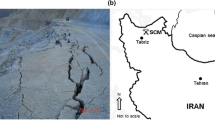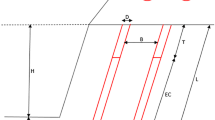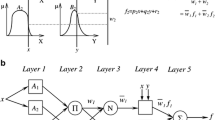Abstract
Backbreak is one of the undesirable effects of blasting operations causing instability in mine walls, falling down the machinery, improper fragmentation and reduction in efficiency of drilling. Backbreak can be affected by various parameters such as the rock mass properties, blasting geometry and explosive properties. In this study, the application of the artificial neural network (ANN), an adaptive neuro-fuzzy inference system (ANFIS) for prediction of backbreak, was described and compared with the traditional statistical model of multiple regression. The performance of these models was assessed through the root mean square error, correlation coefficient (R 2) and mean absolute percentage error. As a result, it was found that the constructed ANFIS exhibited a higher performance than the ANN and multiple regression for backbreak prediction.










Similar content being viewed by others
References
Konya CJ, Walter EJ (1991) Rock blasting and overbreak control. U.S. Department of transportation, Federal Highway Administration
Aghajani Bazzazi A, Mansouri H, Farsangi MAE, Atashpanjeh A (2006) Application of controlled blasting (pre-splitting) using large diameter holes in Sarcheshmeh copper mine. In: Proc. 8th Int. Symp. on rock fragmentation by blasting, Editec S.A., Santiago, pp 388–392
Gate WCB, Ortiz LT, Florez RM (2005) Analysis of rockfall and blasting backbreak problems, US 550, Molas Pass, CO. In: Proceedings of the 40th U.S. symposium on rock mechanics, ARMA/USRMS, 5 June 2005, Anchorage, Alaska, pp 671–680
Demuth H, Beale M (2000) Neural network toolbox for use with MATLAB. The MathWorks, Inc
Meulenkamp F, Alvarez Grima M (1999) Application of neural networks for the prediction of the unconfined compressive strength (UCS) from Equotip hardness. Int J Rock Mech Min Sci 36:29–39
Jang JSR (1993) ANFIS: adaptive-network-based fuzzy inference system. IEEE Trans Syst Man Cybern 23(3):665–685
Ubeyli ED, Guler I (2005) Automatic detection of erythemato-squamous diseases using adaptive neuro-fuzzy inference systems. Comput Biol Med 35:421–433
Alvarez Grima M, Bruines PA, Verhoef PNW (2000) Modeling tunnel boring machine performance by neuro-fuzzy methods. Tunn Undergr Space Technol 15(3):259–269
Gokceoglu C, Yesilnacar E, Sonmez H, Kayabasi A (2004) A neuro-fuzzy model for modulus of deformation of jointed rock masses. Comput Geotech 31(5):375–383
Benardos AG, Kaliampakos DC (2004) Modelling TBM performance with artificial neural networks. Tunn Undergr Space Technol 19:597–605
Singh TN, Kanchan R, Verma AK, Saigal K (2005) A comparative study of ANN and neuro-fuzzy for the prediction of dynamic constant of rock mass. J Earth Syst Sci 114(1):75–86
Khandelwal M, Singh TN (2007) Evaluation of blast-induced ground vibration predictors. Soil Dynam Earthq Eng 27:116–125
Monjezi M, Dehghani H (2008) Evaluation of effect of blasting pattern parameters on backbreak using neural networks. Int J Rock Mech Min Sci 45:1446–1453
Yilmaz I, Yuksek G (2009) Prediction of the strength and elasticity modulus of gypsum using multiple regression, ANN, and ANFIS models. Int J Rock Mech Min Sci 46(4):803–810
Sobhani J, Najimi M, Pourkhorshidi AR, Parhizkar T (2010) Prediction of the compressive strength of no-slump concrete: a comparative study of regression, neural network and ANFIS models. Constr Build Mater 24:709–718
Kucuk K, Aksoy CO, Basarir H, Onargan T, Genis M, Ozacar V (2011) Prediction of the performance of impact hammer by adaptive neuro-fuzzy inference system modeling. Tunn Undergr Space Technol 26(1):38–45
Bahrami A, Monjezi M, Goshtasbi K, Ghazvinian A (2011) Prediction of rock fragmentation due to blasting using artificial neural network. Eng Comput 27:177–181
Iphar M (2012) ANN and ANFIS performance prediction models for hydraulic impact hammers. Tunn Undergr Space Technol 27:23–29
Yilmaz I, Kaynar O (2011) Multiple regression, ANN (RBF, MLP) and ANFIS models for prediction of swell potential of clayey soils. Expert Syst Appl 38:5958–5966
Mohamed MT (2009) Artificial neural network for prediction and control of blasting vibrations in Assiut (Egypt) limestone quarry. Int J Rock Mech Min Sci 46:426-431
White DA, Sofge DA (1992) Handbook of intelligent control: neural, fuzzy, and adaptive approaches. Multiscience Press Inc, New York
Haykin S (1999) Neural networks: a comprehensive foundation, 2nd edn. Prentice-Hall Inc, New Jersey
Jang JSR, Sun CT, Mizutani E (1997) Neuro-fuzzy and soft computing: a computational approach to learning and machine intelligence. Prentice-Hall, Englewood Cliffs
Sumathi S, Paneerselvam S (2010) Computational intelligence paradigms: theory and applications using MATLAB. Taylor and Francis Group, LLC
Esmaeili M, Aghajani Bazzazi A, Brona S (2011) Reliability analysis of a fleet of loaders in Sangan iron mine. Arch Min Sci 56(4):629–640
Alvarez Grima M, Babuska R (1999) Fuzzy model for the prediction of unconfined compressive strength of rock samples. Int J Rock Mech Min Sci 36:339–349
Tzamos S, Sofianos AI (2006) Extending the Q system’s prediction of support in tunnels employing fuzzy logic and extra parameters. Int J Rock Mech Min Sci 43:938–949
Acknowledgments
The authors are thankful to Mr. Amiri, managing director of Sangan Iron Mine Project (SIMP), for his support and collaboration on this study. Authors also would like to thank Reza Moradidoost who kindly provided valuable grammatical suggestions during this research.
Author information
Authors and Affiliations
Corresponding author
Rights and permissions
About this article
Cite this article
Esmaeili, M., Osanloo, M., Rashidinejad, F. et al. Multiple regression, ANN and ANFIS models for prediction of backbreak in the open pit blasting. Engineering with Computers 30, 549–558 (2014). https://doi.org/10.1007/s00366-012-0298-2
Received:
Accepted:
Published:
Issue Date:
DOI: https://doi.org/10.1007/s00366-012-0298-2




